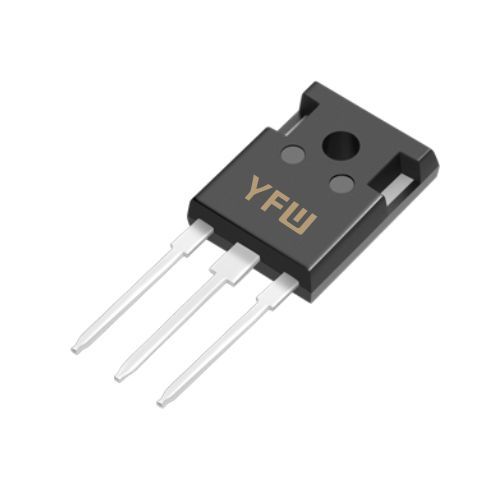The Silicon-Controlled Rectifier (SCR) is the most basic and widely used thyristor, featuring three terminals: anode, cathode, and gate. It conducts current in one direction (rectification) and turns on when a positive voltage pulse is applied to the gate relative to the cathode. Once activated, it remains conducting until the anode current falls below the holding current or the voltage reverses. SCRs dominate in high-power DC applications, such as battery chargers, where they manage large currents efficiently. In AC systems, they control power by triggering at specific phases, seen in dimmer switches and motor speed controllers. Their ruggedness and ability to handle surge currents make them ideal for industrial environments, though their unidirectional conduction and slow switching speed (compared to modern devices) limit use in high-frequency circuits.
The TRIAC (Triode for Alternating Current) is a bidirectional thyristor, conducting current in both directions when triggered. It has three terminals: main terminal 1 (MT1), main terminal 2 (MT2), and gate. Unlike the SCR, a TRIAC can be activated by a positive or negative voltage on the gate, making it perfect for AC power control. This feature simplifies circuits in applications like light dimmers, fan speed regulators, and solid-state relays, where bidirectional current flow is necessary. TRIACs excel in switching loads connected to mains voltage (110V/230V AC), offering compact size and lower control power compared to electromechanical switches. However, they require careful design to avoid false triggering from voltage transients, a common challenge in noisy industrial setups.
The Gate Turn-Off Thyristor (GTO) addresses a limitation of traditional thyristors: once 导通 (conducting, but here described as "activated"), they can only turn off when the anode current naturally drops to zero (line commutation). GTOs introduce active turn-off capability: a negative gate current pulse can force them into the off state, regardless of the anode current. This feature, combined with high voltage (up to 6kV) and current (up to 6kA) ratings, makes GTOs critical in applications requiring fast switching, such as high-power motor drives in electric trains and grid-connected inverters for wind turbines. While their switching speed is slower than insulated-gate bipolar transistors (IGBTs), GTOs remain preferred in ultra-high-power systems where reliability and surge handling outweigh speed considerations.
The MOS-Controlled Thyristor (MCT) and Insulated-Gate Bipolar Transistor (IGBT) represent hybrid devices that bridge thyristor power capabilities with transistor-like control. The MCT uses a MOSFET structure to trigger and turn off the thyristor, offering high switching speeds and low on-state losses, though it never achieved widespread adoption due to manufacturing complexities. The IGBT, a cornerstone of modern power electronics, combines the high input impedance of MOSFETs with the low saturation voltage of bipolar transistors. While not a pure thyristor, it inherits the thyristor’s ability to handle high voltages (up to 6.5kV) and currents, making it dominant in variable-frequency drives, electric vehicle inverters, and renewable energy converters. Its gate-controlled turn-on/off and moderate switching speed strike a balance between efficiency and control, positioning it as a versatile workhorse in medium- to high-power systems.
The Light-Activated Silicon-Controlled Rectifier (LASCR) replaces the electrical gate trigger with optical input—light incident on the device’s sensitive area activates conduction. This galvanic isolation between control and power circuits makes LASCRs ideal for high-voltage applications like power transmission systems, where electrical isolation is critical to safety and signal integrity. They also feature fast response times and immunity to electromagnetic interference, enhancing reliability in harsh environments such as industrial furnaces or aerospace systems.
The choice of thyristor depends on three key factors: current/voltage ratings, conduction direction (unidirectional vs. bidirectional), and control requirements (passive triggering vs. active commutation). SCRs and TRIACs suit low- to medium-power AC/DC switching, while GTOs and IGBTs excel in high-power, actively controlled systems. LASCRs offer specialized isolation benefits, and hybrid devices like IGBTs bridge performance gaps for modern applications.
As power electronics evolve toward higher efficiency and integration, thyristors remain vital, each type optimized for specific challenges. By understanding their classifications—from the foundational SCR to advanced hybrid devices—engineers can leverage these components to design robust, efficient circuits that drive everything from household appliances to grid-scale energy solutions. Whether managing mains voltage or enabling renewable energy conversion, thyristors prove that semiconductor innovation thrives in both simplicity and sophistication
